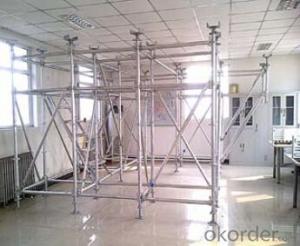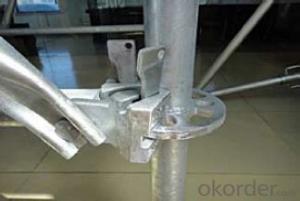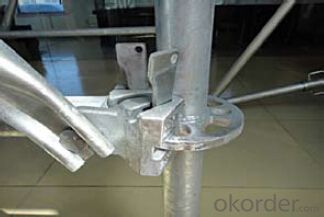Ring-lock Scaffolding Accessories for Formwork and scaffolding System
- Loading Port:
- Tianjin
- Payment Terms:
- TT OR LC
- Min Order Qty:
- 50 m²
- Supply Capability:
- 1000 m²/month
OKorder Service Pledge
Quality Product, Order Online Tracking, Timely Delivery
OKorder Financial Service
Credit Rating, Credit Services, Credit Purchasing
You Might Also Like
Ring-lock Scaffolding
A support system for construction, ownsadvantages of both cup-lock scaffolding andshoring tower.
It is in the development direction of new typescaffolding.
It is widely used in buildings, bridges, tunnels etc..
Characteristics:
◆ Easy to storage and transportation
◆ High degree of standardization
◆ Easy and quick erection
◆ Excellent stability and bearing capacity
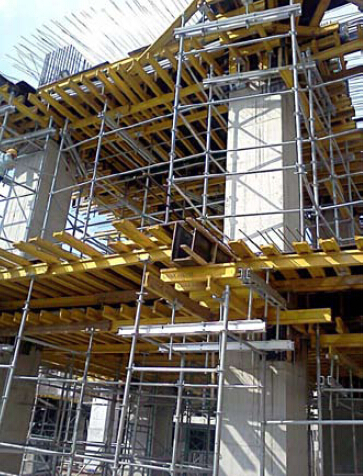
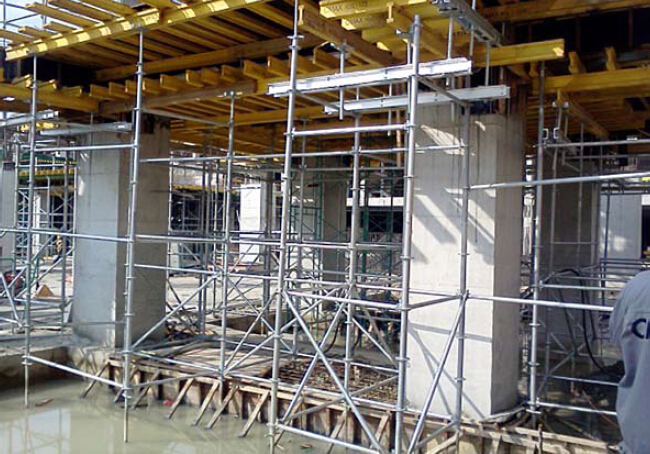
- Q: Can steel formwork be used for both horizontal and vertical concrete placements?
- Indeed, both horizontal and vertical concrete placements can utilize steel formwork. The utilization of steel formwork offers a robust and sturdy framework, rendering it appropriate for a wide range of concrete placements. Its durability and stability enable it to endure the force exerted by the moist concrete, guaranteeing the preservation of its shape and structure throughout the curing phase. Steel formwork exhibits versatility, enabling convenient customization and assembly to fulfill the precise demands of horizontal and vertical concrete placements. Regardless of whether it pertains to the construction of slabs, walls, columns, or beams, steel formwork serves as a dependable and effective solution for generating superior concrete structures.
- Q: Are there any specific considerations for using steel formwork in earthquake-prone areas?
- Yes, there are specific considerations for using steel formwork in earthquake-prone areas. Steel formwork is known for its strength and durability, which is why it is often preferred in seismic regions. However, there are several factors that need to be taken into account when using steel formwork in earthquake-prone areas: 1. Flexibility: Steel formwork should be designed to have the necessary flexibility to withstand seismic forces. It should be able to absorb and dissipate the energy generated during an earthquake, reducing the risk of structural damage. 2. Connection details: The connection details between the steel formwork components should be carefully designed and engineered to ensure proper load transfer and resistance to seismic forces. Special attention should be given to the joints and connections to prevent failure or collapse during an earthquake. 3. Reinforcement: Additional reinforcement might be required to enhance the strength and stiffness of the steel formwork system. This reinforcement can be in the form of additional steel bars, cross bracing, or diagonal struts to provide increased resistance against lateral forces. 4. Anchorage: Proper anchorage of the steel formwork to the supporting structure is crucial in earthquake-prone areas. The formwork should be securely anchored to the foundation or the structural elements to prevent displacement or movement during an earthquake. 5. Inspection and maintenance: Regular inspection and maintenance of the steel formwork system are essential in earthquake-prone areas. Any damage or wear should be identified and repaired promptly to ensure the integrity and stability of the formwork system. 6. Compliance with building codes: It is important to ensure that the steel formwork system complies with the local building codes and regulations for seismic design. These codes provide guidelines and requirements for the design, installation, and use of formwork in earthquake-prone areas. By considering these specific factors, using steel formwork in earthquake-prone areas can provide enhanced structural resilience and contribute to the overall safety and durability of the construction project.
- Q: How does steel formwork affect the overall construction site logistics?
- Steel formwork can have a significant impact on the overall construction site logistics. Firstly, steel formwork is known for its durability and strength, which allows for multiple reuses. This reduces the need for constant replacement and disposal of formwork materials, resulting in reduced waste generation and improved site cleanliness. Additionally, steel formwork is lightweight and easily adjustable, making it easier to handle and transport around the construction site. This enhances the efficiency of material handling and reduces the time required for formwork installation and removal. Moreover, the lightweight nature of steel formwork reduces the load on the structure, resulting in reduced transportation costs and improved safety during construction. Steel formwork also offers high dimensional accuracy, ensuring precise and consistent shapes for concrete elements. This precision can help streamline the construction process, as it reduces the need for excessive adjustments and rework. This leads to improved time management and increased productivity on the construction site. Furthermore, steel formwork provides a smooth and even finish to concrete structures, resulting in better-quality finishes. This can eliminate the need for additional surface treatments and reduce the time and effort required for finishing work. Overall, steel formwork contributes to improved construction site logistics by reducing waste, enhancing material handling efficiency, improving construction speed, and ensuring high-quality finishes. Its durability, lightweight nature, and dimensional accuracy make it a valuable asset in optimizing construction processes and achieving project timelines more effectively.
- Q: Can steel formwork be used for precast concrete arches?
- Precast concrete arches can indeed utilize steel formwork. This material, known for its versatility and durability, proves highly capable of constructing intricate shapes and structures, including arches. During the casting process, steel formwork offers exceptional support and stability, ensuring the precise and accurate formation of arches. Moreover, steel formwork easily adapts to various arch designs and dimensions, thanks to its customizable nature. Its strength and rigidity further enable it to withstand the pressure and weight of the concrete during the curing process. Consequently, steel formwork emerges as the preferred choice for constructing precast concrete arches due to its flexibility, strength, and reliability.
- Q: Are there any specific considerations for using steel formwork in areas with high wind loads?
- Yes, there are several specific considerations for using steel formwork in areas with high wind loads. Firstly, the design of the steel formwork needs to be robust and able to withstand the potential forces exerted by strong winds. This includes ensuring that the formwork is properly anchored to the ground or structure to prevent displacement or collapse. Additionally, the formwork must be properly braced and reinforced to resist the lateral forces generated by high winds. This may involve the use of additional cross-bracing, diagonal supports, or stiffeners to enhance the structural integrity of the formwork. The materials used in the construction of the steel formwork should also be carefully selected to withstand the corrosive effects of wind-driven rain, saltwater spray, or other environmental factors that may be present in high wind load areas. This may involve using corrosion-resistant steel or applying protective coatings to prevent rust or deterioration. Furthermore, the erection and dismantling of the steel formwork should be carefully planned and executed, taking into account the potential risks associated with high winds. It is important to follow appropriate safety procedures and guidelines to ensure the stability and integrity of the formwork during installation and removal. Lastly, regular inspections and maintenance of the steel formwork should be conducted to identify and address any potential issues or damage caused by high winds. This may include checking for loose connections, signs of deformation, or any other signs of structural compromise. In conclusion, using steel formwork in areas with high wind loads requires careful consideration and implementation of specific measures to ensure the safety and stability of the formwork. By addressing design, reinforcement, material selection, installation, and maintenance, the steel formwork can effectively withstand the challenges posed by high winds.
- Q: How does steel formwork contribute to the fire resistance of the structure?
- Steel formwork, also referred to as steel molds or frames, plays a crucial role in enhancing the fire resistance of a structure. Primarily, steel possesses inherent fire-resistant properties due to its high melting point and low combustibility, making it an optimal choice for formwork in areas prone to fires. When steel formwork is employed in construction, it imparts strength and rigidity to the structure, thereby preserving its integrity during a fire. These steel molds securely hold the concrete in place, preventing its collapse or disintegration when exposed to elevated temperatures. This structural stability enables firefighters to enter the building safely and extinguish the fire without concerns of sudden structural failure. Furthermore, steel formwork acts as a heat sink during a fire by virtue of its high thermal conductivity. This characteristic facilitates the rapid absorption and dissipation of heat, thereby minimizing the spread of fire and reducing the overall temperature within the structure. By absorbing heat, steel formwork effectively delays the occurrence of concrete spalling or cracking, thereby maintaining the structural integrity of the building for an extended duration. In addition, steel formwork is often designed with appropriate fire-resistant coatings or insulation materials. These coatings provide an additional layer of protection against heat, flames, and smoke generated during a fire. They also aid in impeding or slowing down the transfer of heat to the concrete, thereby further augmenting the fire resistance of the structure. Overall, the utilization of steel formwork significantly enhances the fire resistance of a building by providing structural stability, functioning as a heat sink, and incorporating fire-resistant coatings or insulation materials. By incorporating steel molds, architects and engineers can ensure the safety and longevity of the structure, even in the event of a fire.
- Q: Can steel formwork be used for both slab and beam construction?
- Indeed, steel formwork is applicable for both slab and beam construction. Within the construction industry, steel formwork proves to be a flexible and long-lasting alternative for constructing slabs and beams. It furnishes a robust and inflexible framework that can endure the weight and pressure exerted by the poured concrete. With easy assembly and disassembly, steel formwork emerges as a fitting choice for diverse construction undertakings. Its sturdiness and steadiness render it an optimal selection for both slab and beam construction, guaranteeing that the concrete structures adhere to the necessary specifications and can adeptly bear the loads they are designed for.
- Q: What are the considerations when designing steel formwork for underground utilities?
- There are several essential factors to consider when designing steel formwork for underground utilities. These considerations encompass: 1. Structural Integrity: It is necessary to ensure that the formwork can withstand the pressure and forces exerted by the surrounding soil and any potential external loads. The design should offer sufficient strength and stability throughout the construction process. 2. Water and Chemical Resistance: Underground utilities are often exposed to water and various chemicals. Consequently, the formwork must be designed to resist corrosion and deterioration caused by these elements, ensuring its durability. 3. Accessibility for Installation and Maintenance: The formwork design should facilitate easy access during installation and future maintenance activities. This may involve incorporating provisions for openings, removable sections, or access points to allow workers to easily reach the utilities when necessary. 4. Modular Design: Utilizing a modular design can provide flexibility and simplify installation. Modular formwork systems enable quick assembly and disassembly, which proves advantageous when dealing with different underground utility layouts and configurations. 5. Safety: Safety is of utmost importance in any construction project. Therefore, the formwork design should include safety features such as guardrails, handrails, and anti-slip surfaces to minimize the risk of accidents and injuries during construction and maintenance. 6. Cost-effectiveness: The design should strike a balance between performance and cost. It should be optimized to minimize material usage and labor costs while maintaining quality and durability. 7. Compatibility with other construction methods: The design should be compatible with other construction methods and materials used for the underground utilities. This encompasses considerations for joining techniques, such as welding or bolting, and compatibility with other materials, such as concrete or PVC pipes. By taking these factors into account, designers can ensure that the steel formwork for underground utilities is structurally sound, resistant to environmental factors, easily accessible for installation and maintenance, safe for workers, cost-effective, and compatible with other construction methods.
- Q: Are there any specific considerations for using steel formwork in seismic zones?
- Yes, there are specific considerations for using steel formwork in seismic zones. Steel formwork is known for its high strength and rigidity, which makes it suitable for withstanding seismic forces. However, it is essential to ensure that the steel formwork is designed and installed correctly to withstand the expected seismic loads. This includes using robust connections, adequate bracing, and proper reinforcement. Additionally, the formwork should be inspected regularly to identify any potential vulnerabilities or damage that could compromise its performance during an earthquake.
- Q: How does steel formwork affect the overall productivity of the construction process?
- The overall productivity of the construction process can be significantly influenced by steel formwork. Firstly, steel formwork is renowned for its durability and strength, enabling it to withstand the immense pressure and force exerted by concrete during pouring and curing. This durability ensures that the formwork remains intact and stable, reducing the need for repairs or replacements, thereby saving time and cost. Additionally, assembly and disassembly are made more efficient with steel formwork. Steel panels can be easily connected and detached, allowing for swift and seamless installation and removal. This ease of use ensures that construction can progress at a quicker pace, ultimately increasing overall productivity. Furthermore, steel formwork delivers a smooth and high-quality finish to concrete structures. The precise and rigid nature of steel formwork prevents any deformations or warping during pouring and curing stages, resulting in a superior surface finish. This eliminates the need for additional finishing work, such as plastering or smoothing, thereby reducing the time and effort required for post-construction tasks. Moreover, steel formwork is highly adaptable and can be customized to accommodate various shapes and sizes, facilitating the construction of complex structures with ease. This flexibility allows for greater design freedom and eliminates the necessity for additional supporting structures, ultimately reducing construction time and increasing productivity. Lastly, steel formwork is reusable and can be utilized for multiple projects, unlike traditional timber formwork which often requires disposal after a single use. This reusability not only reduces material waste but also saves time and cost in procuring new formwork for each project. In conclusion, steel formwork significantly enhances the overall productivity of the construction process. Its durability, ease of assembly, high-quality finish, adaptability, and reusability all contribute to faster construction timelines, reduced costs, and improved efficiency, making it a preferred choice for many construction projects.
Send your message to us
Ring-lock Scaffolding Accessories for Formwork and scaffolding System
- Loading Port:
- Tianjin
- Payment Terms:
- TT OR LC
- Min Order Qty:
- 50 m²
- Supply Capability:
- 1000 m²/month
OKorder Service Pledge
Quality Product, Order Online Tracking, Timely Delivery
OKorder Financial Service
Credit Rating, Credit Services, Credit Purchasing
Similar products
Hot products
Hot Searches
Related keywords
